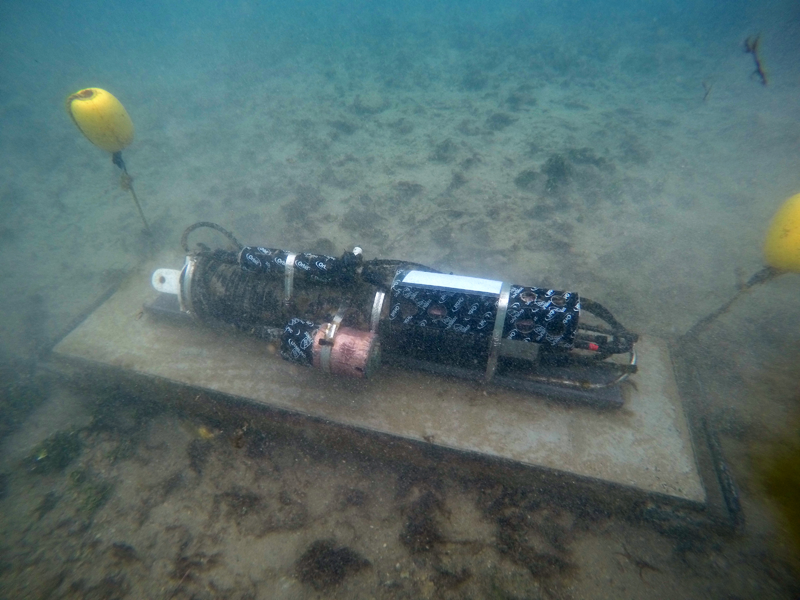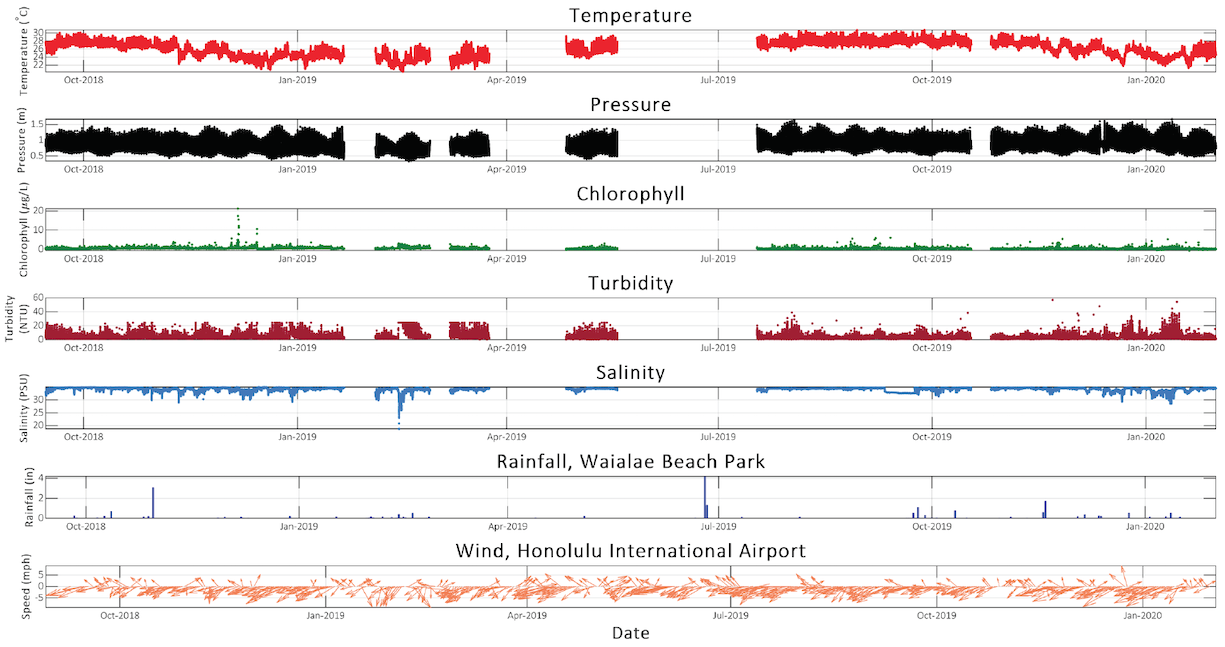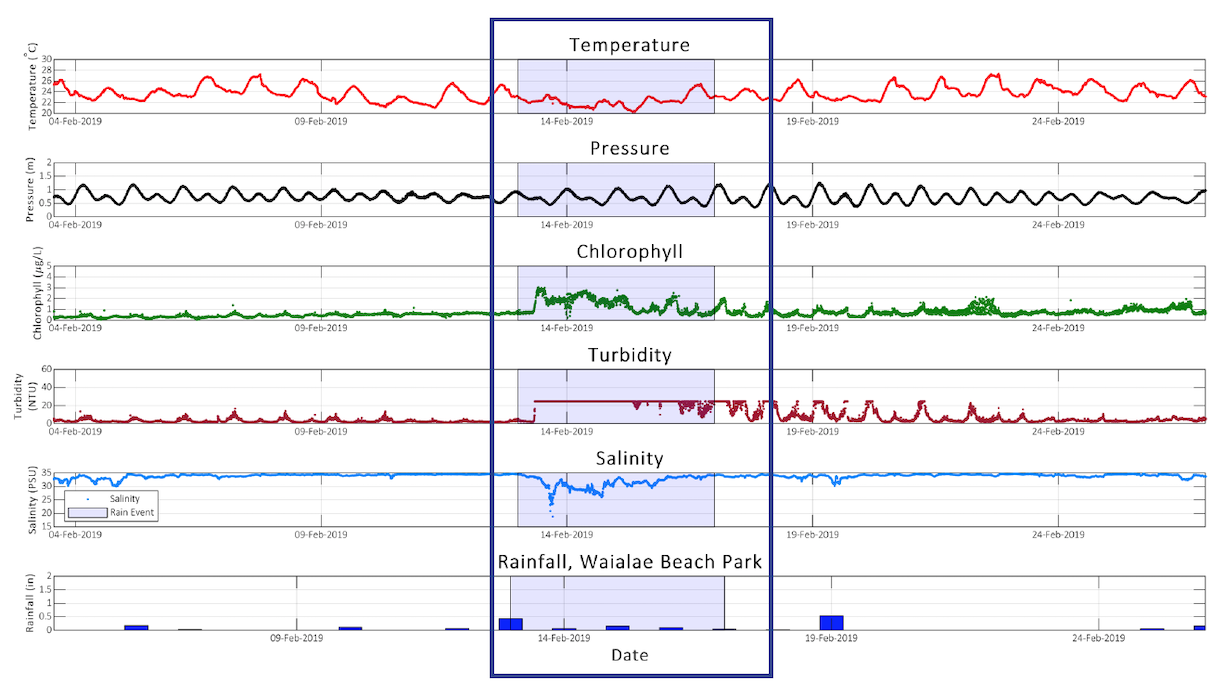Nearshore Sensor Observations : Archive : Kāhala, Oʻahu
This site has been decommissioned and is no longer collecting new data.
NOTE: Click on the plot below for data at a specific time.
NOTE: This instrument does not report in real-time. New data are retrieved periodically.
start date: : temperature: wave height: wind: rain: currents: site:
Disclaimer: Near real-time data have not been quality controlled.
Disclaimer: Data are released in compliance with real-time quality control standards.
Disclaimer: Real-time data are provided as raw and unaltered. Results of quality control checks are provided within the data set.
This nearshore sensor (nss_wqspp_005) operated for nearly a year and a half between September 14, 2018 and January 31, 2020. It was located approximately 100 meters offshore of Waiʻalae Beach Park in Kāhala along the west side of Maunalua Bay on the South Shore of Oʻahu in the State of Hawaiʻi. The sensor package was mounted to the sea floor at approximately 1.5 meters depth. Data were recorded every 4 minutes.

Instrument site. Credit: PacIOOS/Gordon Walker.
The PacIOOS Water Quality Sensor Partnership Program (WQSPP) supports scientists and natural resource managers to collect water quality data in order to inform research, conservation, planning, and resource management projects in the U.S. Insular Pacific region. Comprised of a network of “roving” water quality nearshore sensors, the WQSPP provides participating partners with sensors, data management, and technical capacity-building to allow for robust data collection.
As part of the WQSPP, Mālama Maunalua was awarded a PacIOOS nearshore sensor to enhance water quality monitoring efforts in Maunalua Bay. Mālama Maunalua is a community-based, non-profit stewardship organization committed to conserving and restoring a healthy and productive Maunalua Bay. The sensor collected critical parameters at Waiʻalae Stream mouth and stormwater outlet to assess sediment loads and water input. The data helped to inform ongoing work at Pāiko Restoration Area, which is adversely impacted by invasive algae. The sensor also complemented the existing PacIOOS sensor on the eastern side of Maunalua Bay (NSS-010) to improve the understanding of bay-wide, land-based inputs. Owned and maintained by PacIOOS under the supervision of Dr. Margaret McManus and lab.
Download a pdf summary sheet here
Data at a Glance
Data from this sensor package are used to characterize temporal variability in the water column properties at Waiʻalae Beach Park within Maunalua Bay, Oʻahu. Deployment extended from September 2018 to January 2020. Gaps in data are due to battery issues with the sensor.

Daily fluctuations in temperature (Celsius) are due to solar heating. Seasonal fluctuations in temperature are evident within the dataset. Temperature ranges from 20.27 °C to 30.07 °C with an average of 25.27 °C.
Pressure (meters) measures the water height above the sensor. Changes in pressure are due to Hawaiʻi’s mixed semidiurnal tide cycles (two highs and two lows per day). Pressure ranges from 0.33 m to 1.47 m, with an average of 0.81 m.
Chlorophyll (micro grams/liter) is a pigment found in phytoplankton, and is measured to monitor their presence. Fluctuations may be correlated with seasonal change and increased nutrient flux from surface water runoff. Chlorophyll ranges from -0.03 μg/L to 6.71 μg/L, with an average of 0.99 μg/L.
Turbidity (nephelometric turbidity units) shows the change in suspended particles in the water column from surface water runoff and shifts in daily tides. Turbidity ranges from 0.97 NTU to 56.96 NTU, with an average of 4.31 NTU.
Salinity (practical salinity units) fluctuates largely with freshwater input from land-based sources (e.g., stream and rain runoff). Salinity ranges from 18.75 PSU to 34.91 PSU, with an average of 34.12 PSU.
Rainfall (Weather Underground) and wind (National Weather Service) data are displayed to show correlations between the fluctuations seen in the above parameters. Rain events show a relationship between the above parameters. Wind does not appear to show any notable relationship.
Case Study
To get a better understanding of how each parameter is connected, we are taking a closer look at a single event. In this case study we focus on a period of rainfall (highlighted in blue) that occurred in February 2019. By comparing each measured parameter, we are able to see how one additional change to the environment can actually affect many aspects of our nearshore waters.

Rain Event
The average rainfall accumulated between February 10 and February 19, 2019 was 0.16 in. The maximum level was 0.53 in, occurring on February 19. While this period does not include the greatest amount of rainfall recorded over the duration of deployment, it does show an increased precipitation with a dropping tide.
A dropping tide and decrease in pressure means less salt influx from offshore waters, offering a higher chance for freshwater input to drop the average level of salinity.
Salinity across this case study ranged from 18.75 PSU to 34.17 PSU, with an average of 33.54 PSU—which is lower than the average across the entire deployment. The largest drop in salinity over the duration of this study is documented on mid-day February 13, 2019. This dip is correlated with increased rainfall over the same time period.
Chlorophyll levels rise as runoff and nutrient levels increase and initiate algal growth. As these photosynthetic microorganisms multiply, so does the amount of chlorophyll pigment measured in the water. This case study shows a slight increase in chlorophyll over the course of this rain event.
Turbidity levels increase as more particulates become suspended in the water column and as different water masses are advected over the sensor. Rain events can increase the amount of sediment that streams bring to nearshore waters. Unfortunately, this event occurred prior to making adjustments to the calibration of the sensor. The maximum recorded turbidity level during this period was recorded at 24.57 NTU, which does not accurately represent the full extent of turbidity expected for this event.
Lastly, temperature was also affected by the influx of cooler, fresh water. The lowest temperature found during deployment was 20.27 °C. This drop occurred the morning of February 15, 2019.
Conclusion
Looking closely at events like this helps us to understand the drivers of the nearshore system. The parameters measured over the course of the partnership between Mālama Maunalua and the PacIOOS WQSPP are within normal and expected ranges and have been compared against the long-term PacIOOS nearshore sensor in Maunalua Bay.







